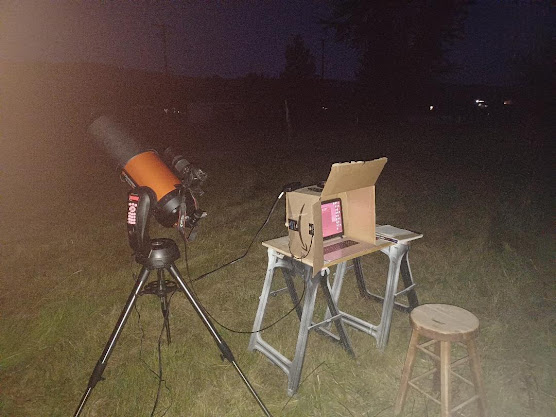14 August 2023 Observing Notes
This night was my first attempt at using our DSLR (Canon Rebel EOS T7) on the piggyback mount. When mounted, the camera aligns very well in altitude, just had to make a slight adjustment in azimuth. I used a tree top about a mile away as the alignment target. I had to set up within 50 feet of the house. I was using a trial version of Backyard EOS for the camera control and capture software, and it has to maintain a wifi connection to work. Because of where I had to set up, the sky available not blocked by trees was from NNE to SE. The camera is connected to the laptop using a USB cable. The lens on the camera was a Canon EF75-300 zoom. I had it at 300mm focal length, which gives an F number of 5.6.
Given the available sky, and my desire for a fairly bright target, I chose the Andromeda Galaxy, M31. After aligning the scope using 2 star alignment, I visually centered M31 in the eyepiece and observed it visually after the imaging started. Note that live view in the camera didn't really show the target. Backyard EOS allows you to set up the imaging run and have it run automatically. I set it up and ran 50 shots, with 10 second exposure and ISO 1600. I programmed a 5 second delay between shots so the image could settle after any mirror slap. At 10 seconds the scope was tracking well enough that I didn't notice any trailing in the stars. I was also observing visually.That little fuzzy spot in the center is Andromeda. This is one of the 50 RAW images.Normally these would be processed in a program such as Siril, that calibrates and stacks the images. It can then be cropped to zoom in more on the specific target. I messed up on taking the calibration images, so was unable to get Siril to process the images correctly. I hope to eventually redo this imaging session so I can get a good image.
After imaging, Saturn was up and visible to the SE, so I decided to try it. Seeing was steadier tonight than the last time I tried Saturn. I was actually able to use the 8mm eyepiece (254x). My sketch is out of scale for the actual view in the eyepiece, so I could show the increased detail I could see. The gap between the rings and planet wee easily seen, and two of the moons. There were period of very staedy seeing, during which I could definitely make out two band on the planet and faint brownish color to them.I also tried three imaging runs on Saturn, but with just the camera lens the image is too small. Planetary imaging is actually done using "lucky: imaging. You actually take short videos, and the software picks the steadiest frames to stack.
After Saturn went behind the trees, I targeted Neptune. I located it, but it was essentially just a very bright star with no obvious color. I should note that it was only about 15-20 degrees above the mountains.
Here are links to tutorials on Backyard EOS, imaging with a DSLR, and Siril.
Interview with the Backyard EOS developer where he answers questions and walks through running it. https://youtu.be/z3gkw8bx7Aw
Deep Sky Photography with a DSLR on a tracking mount (what the piggyback on my Nexstar 8SE is essentially). This includes processing with Siril.
https://www.youtube.com/watch?v=C-X3ky6x8ss






Comments
Post a Comment